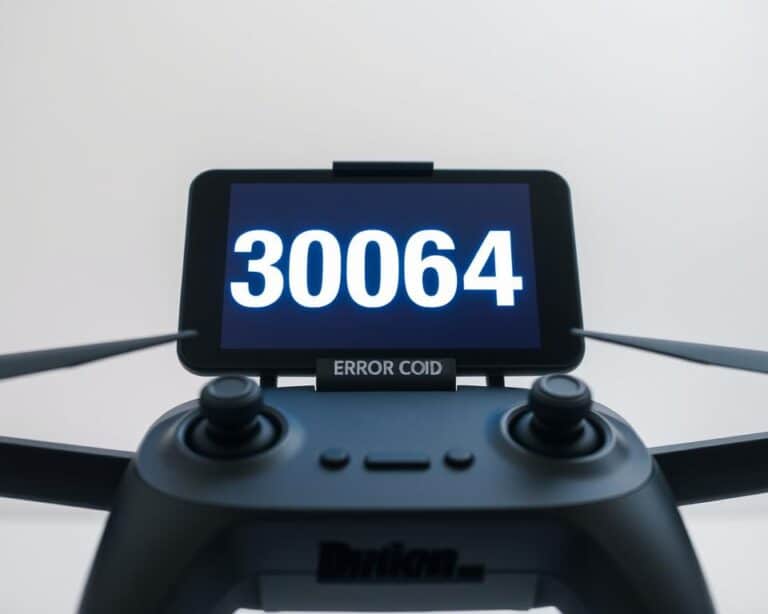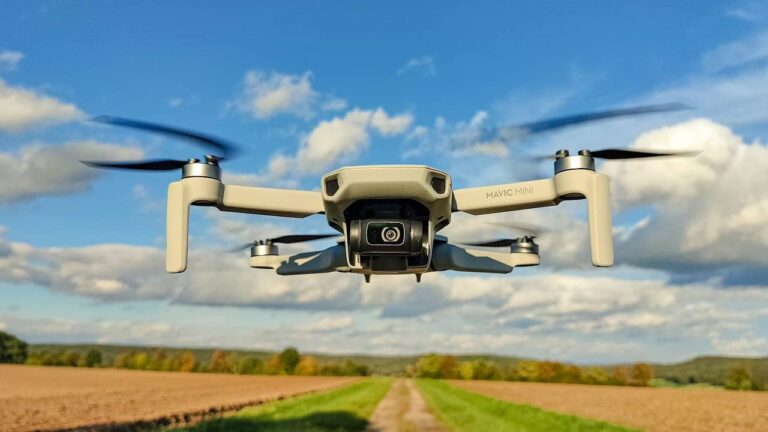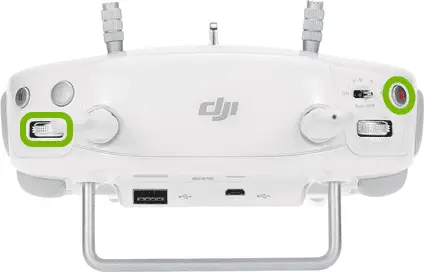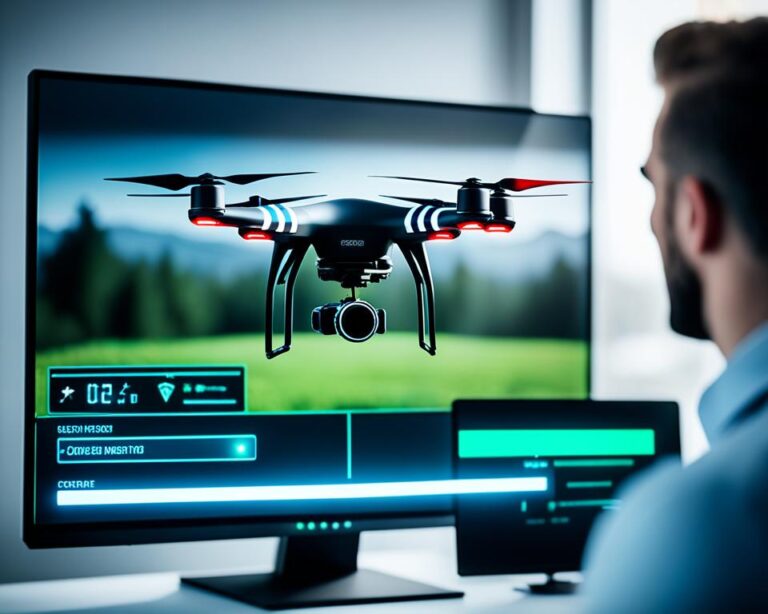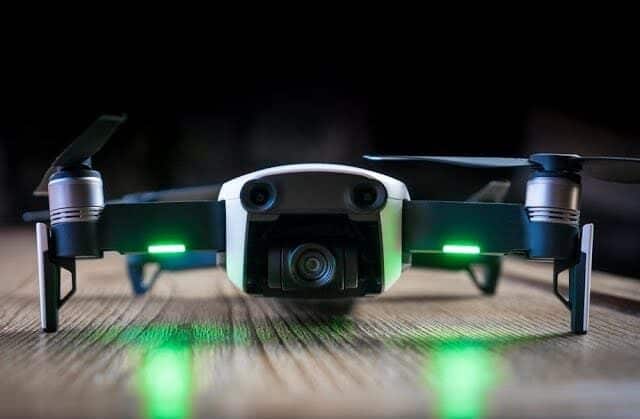Can Drones Fly in Rain- waterproofing and experiments
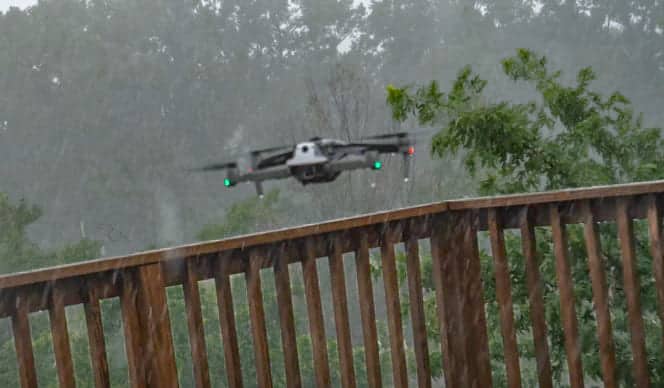
As a drone enthusiast, I love asking questions, and one question I asked was can you fly drones while it is raining?, after a couple of experiments and some research here is what I found-
It is not recommended to fly drones in rain, mist, high humidity, and over water-bodies with strong turbulence. If moisture finds its way in, it can cause a system failure making the drone inoperable and causing it to crash. furthermore, rain can cause corrosion which can damage the drone permanently.
You can waterproof your drone using silicone conformal coating
But before we get to the details it is better if you understand what IP ratings are.
Drone IP Ratings
IP rating is basically a two-digit number that shows the degree of protection provided by an electrical enclosure against dust and water.
A high IP rating means your motors are fully enclosed, the battery is sealed and the inside components such as the motherboard are protected against dust and rain.
Which is especially important if you’re looking to fly your drone in rain or in any situation where weather conditions might change quickly.
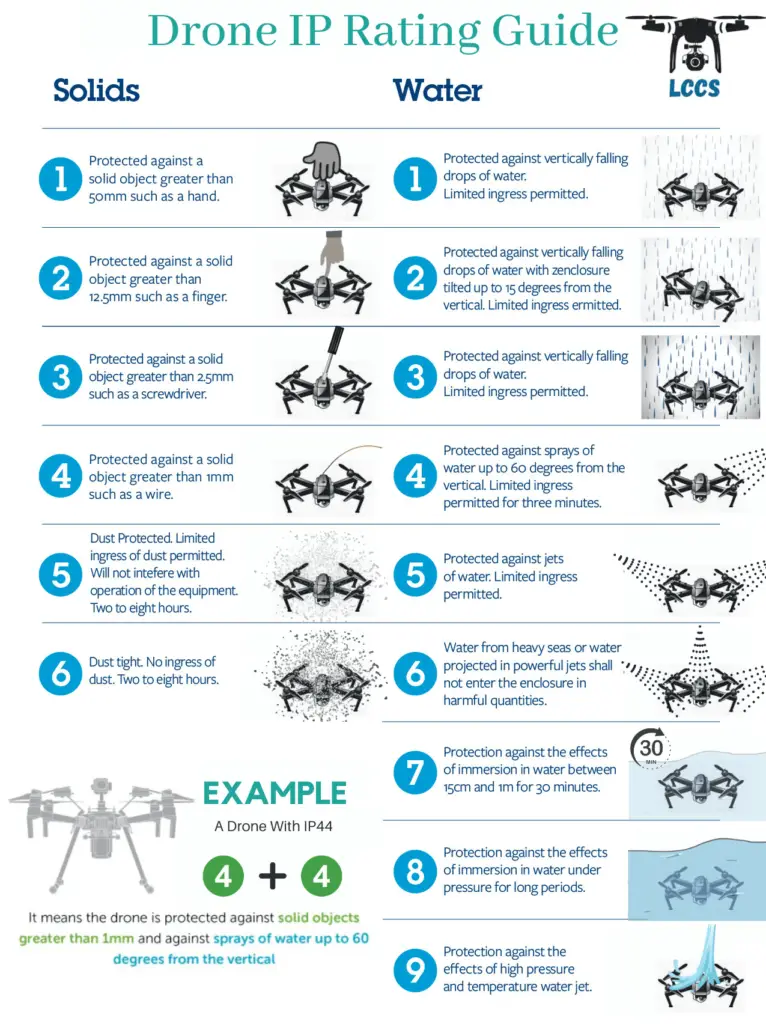
Note: when looking for drones you might come across IP ratings such as “IPx3 or IPx4”, this actually means the drone is only rated for water.
Can you fly a drone in the rain
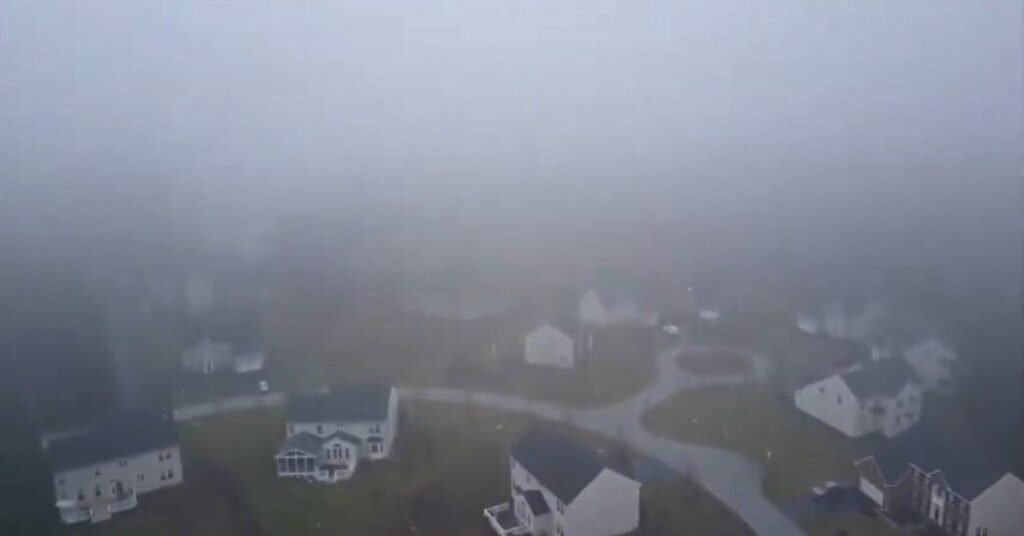
Manufacturers like to play safe and tell their customers far below what their product is capable of, to avoid complications and lawsuits
Now I am not going to say go and fly your drone in the rain because that can certainly get me in trouble for misleading you.
However, I have been able to do that several times and so did hundreds of people which you can watch on youtube.
Now it is true that if moisture comes through the vent it can mess a multitude of things.
but how likely is it?
So, the vent is usually located on the front side of the drone just like car radiators or can be under the drone sometimes, and it is usually the weak link and it is what makes drones vulnerable to water damage.
This vent is what allows your drone to breathe and prevent overheating, so it is almost impossible to get rid of.
Depending on where the vent is located the angle at which the rain falls on the drone can have a significant influence.
For instance on DJI’s popular drone Mavic Pro, the vent is located on the front.
And if you have noticed the vent on Mavic pro has a cover on it to decrease the likely hood of water damage.
The fact that there is a neatly designed cover shows how DJI has put a lot of effort to make the drones water-resistant! even though they are not going to say it.
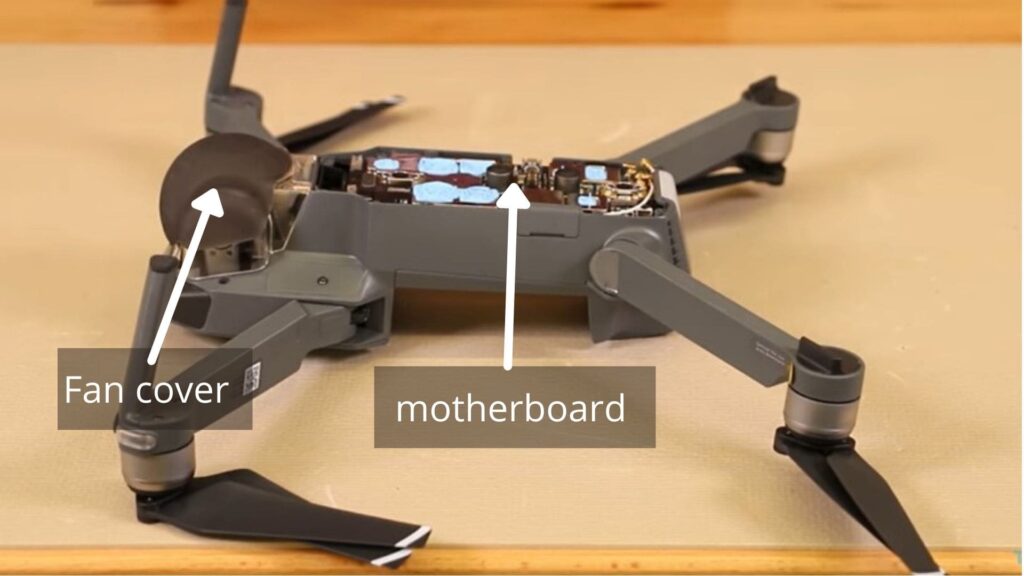
On drones such Mavic pro the steeper the angle at which the rain falls the better because we want the rain hitting the vent at a 90-degree+ angle.
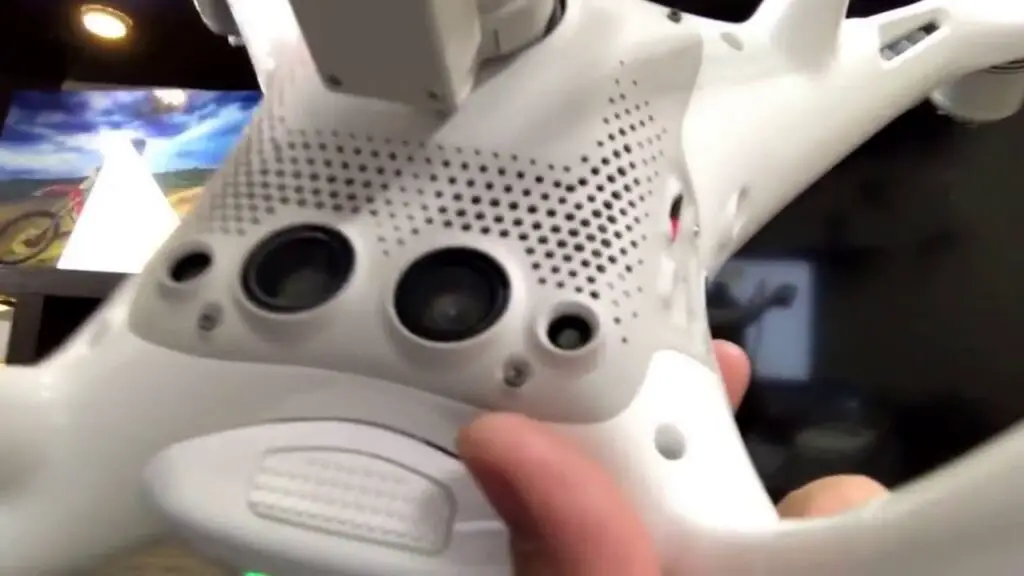
If the vent is located under the drone for instance on DJI phantom 4, the direction of the rain will not have a significant effect unless the drone is accelerating in that case the drone will have a tilt so rain particles that are going sideways will have more chance to get into the drone.
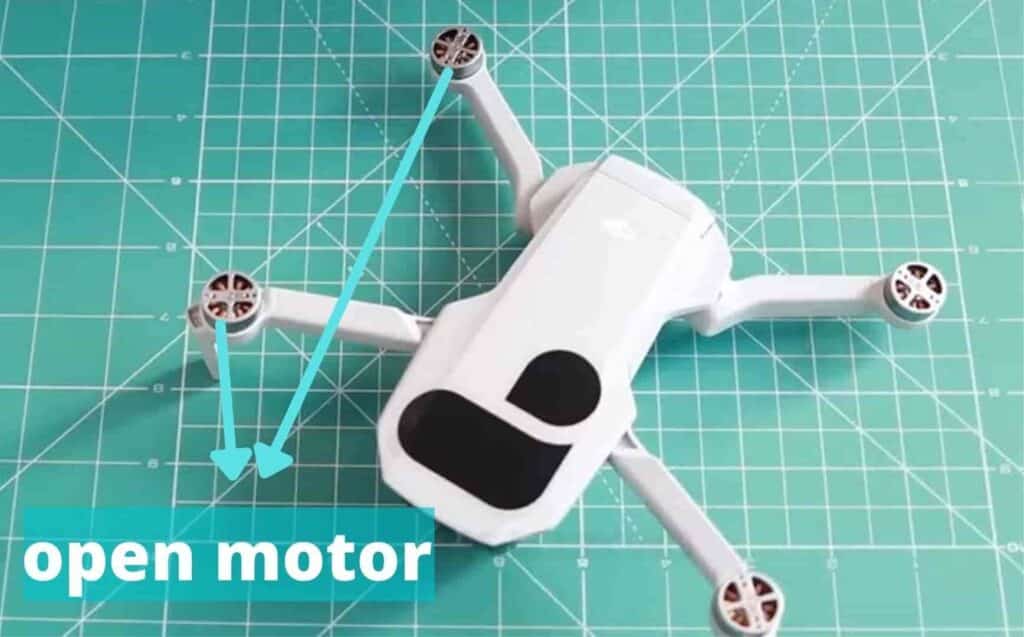
And drones such as on Mavic mini, rain can directly penetrate the copper windings in the electric motor because they lack motor cover, and even though copper never rusts it can form a green film(patina), on its surface over time, which makes the motor notchy.
In what kind of situation is rain likely to go into your drone?
- Strong wind– If there is a strong wind, raindrops will be scattered into much smaller particles which makes them more likey to slip into the drone.
- when flying at a high speed– Flying at a high speed will increase the amout of rain it will encounter plus the
- If the drone is flying at a steep angle to the rain– drones are the most vulnerable when flying at a steep angle to the rain or in other words when decreasing altitude at a high speed or doing stunts by flipping the drone upside down.
What are the challenges when flying a drone in the rain
Keeping your drone in Visual Line Of Sight
When operating sUAS (small unmanned aircraft system) F.A.A recommends keeping them in VLOS at all times.
VOLS is the distance in which the pilot can maintain an unaided visual contact with the drone, it is typically 500 meters radius from the pilot.
VLOS significantly decreases harsh weather conditions which can make it difficult to operate UAVs.
Legal issues
There is no law against flying in rain as of September 2021.
Even though there is no law against flying in the rain, F.A.A advocates operating in a careful manner and it can be considered as a careless manner to operate a drone while it is raining.
Not only that but if water gets into your drone it can cause a short circuit(A short circuit is when current travels along an unintended path), if that happens your drone can fall from the sky just like a brick and that can cause property and/or physical damage and/or complicated legal issues.
Vision sensors
Most drones have several sensors, the ones that can be affected by rain are the vision sensors.
vision sensors are optical sensors that help with stabilization and obstacle avoidance.
when these sensors are covered with water droplets, it makes it hard for both the drone and the operator to operate properly.
Controller
The controller shouldn’t by any means come in contact with water, if the controller gets damaged it can lead to the same results as when the drone is damaged, a crash!
Does DJI make waterproof drones
For something to be called waterproof, it has to be fully submerged in water and stay fully functional, so none of DJI drones are waterproof except DJI Agras and DJI MATRICE series but they are both made for different applications.
The reason DJI does not make waterproof drones is because it is crucial for a drone to have a venting system and with a vent, there is an opening, with an opening there is a way for water to go in, just like why there are no waterproof laptops yet.
However, no one is trying to go diving with their drone most people just want to know if they can fly their drone while it is raining, right?
So in that sense, we can say that most DJI drones are water-resistant to some degree, if you take your time and examine DJI drones you will clearly understand how DJI have tried trying to make them as water-resistant as possible, but they won’t tell you anything because both you and DJI can get in trouble any anything happens!
However as a personal opinion out of DJI drones, Phantom 4 is by far the best in terms of water resistance, and Mavic mini on the other hand is the worst.
If you were to ask me to rate phantom 4 on the Ingress Protection scale I would give it ip32 or more but don’t take my word it is just an opinion.
| DJI DRONES | IP RATINGS |
|---|---|
| DJI M 200 SERIES | IP43 |
| Mavic PRO 1 and 2 | unspecified |
| DJI Phantom 4 | unspecified |
| DJI Agras | IP54 |
| DJI Mini | 0 |
| DJI FPV | Unspecified |
Unspecified doesn’t actually mean the drone has zero protection, it means DJI will not be taking responsibility for any water damage.
By the way, I have flown my Mavic pro in the rain check this article out if to see how it went.
How to waterproof your drone for rain adventure
Even though there is no way you can completely waterproof a drone there are 2 popular and somewhat effective ways drone pilots use to prepare their drones for operating in rain.
The first and the easiest is by using a wetsuit.
Wetsuits for drones
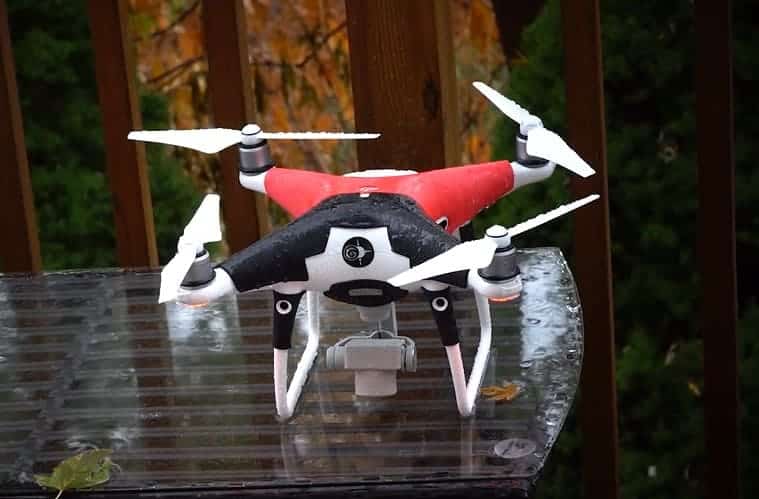
Wetsuits are neoprene covers that help to cover vulnerable parts of a drone and they are becoming more and more popular in the drone enthusiast community.
If you haven’t seen one before they are just like the ones people use for diving.
I personally am not a big fan, because of how expensive they are! the one I bought for my phantom 4 was around $100.
I have tried them both in heavy and light rain and they are quite effective.
However, you should also understand they are not going to waterproof your drone completely they just cover some sensitive parts such as the battery.
Silicone conformal coating
Using silicone conformal coating is the safest way to waterproof any kind of electronics, including drones.
The procedures are quite simple however you can void your warranty by doing so!
What you do is remove the battery then remove the frame then apply a thin layer of Silicone conformal coating on every circuit board then let it dry then put the drone buck up then you are good to go for months.
If you want to know more about this you can find very helpful videos on youtube
Water damage
Water damage can happen in different ways, just because your drone is turning on or take off doesn’t mean that all is well.
- You may suffer intermittent failure in transmitter communication which can lead to a lost drone and a crash.
- You can have dropouts on the GPS signal.
- If the electronic speed controller suffers a damage, then the balance of the drone may lose resulting in a crash.
- water can eventually cause corrosion which can damage the drone permanently.
What to do if your drone suffers moisture ingress?
- Cut off the power supply– if you suspect moisture is inside the drone the first thing to do is to turn off the power supply and remove its battery immediately.
- Dry the internal components– open up the frame and put it in rice to suck up the moisture and make sure you wait for a few days before you fly it again to make sure it is dried out well.
Why would you want to fly a drone in the rain
New drone owners especially young folks become so excited when they first buy a drone and they can’t wait till rain stops and so they can fly their drone again.
However to risk a piece of an electronics that cost hundreds and even thousands of dollars you need to have a good reason
So if enthusiasm is your main drive to do it I recommend using something like DJI simulator to get the feeling of operating your drone
You need to own A DJI drone to use the DJI simulator and I can tell you it is a quite interesting software!
However, if you have a client or it is important to operate your drone you should understand few things.
- Rain will cover your camera lens no matter how you try you will not get great shots, my thought process when I was about to fly my drone in the rain was I will be able to record the city and get great shots however it was neither visible nor enjoyable!
- And finally never use first-person view goggles while it is raining!

